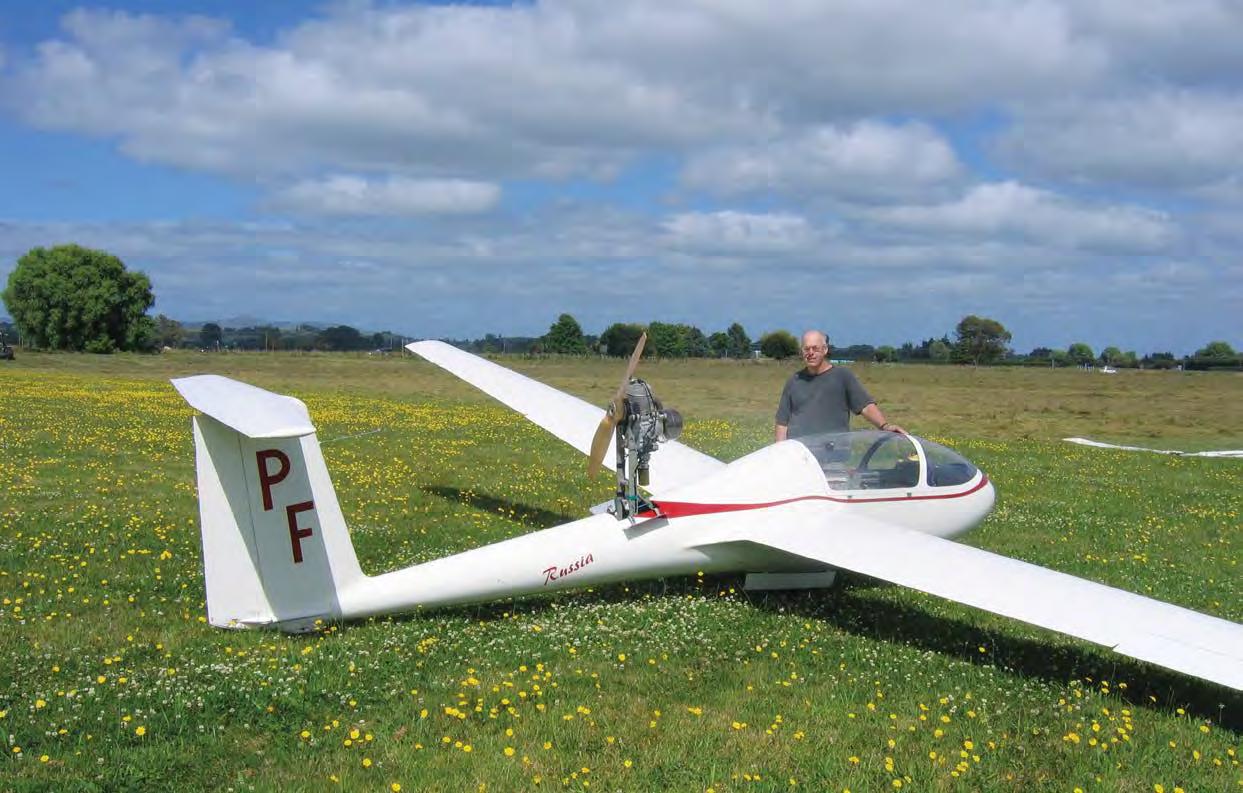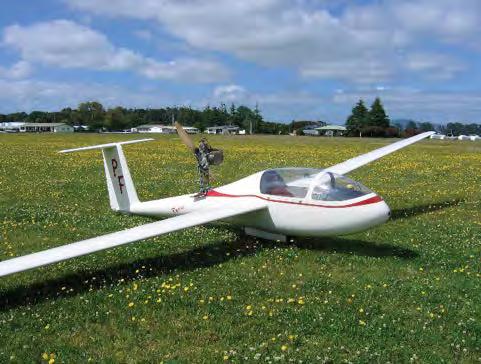
7 minute read
Wonderful Russian Starlet
from SoaringNZ Issue 15
by mccawmedia
My all too brief affair with a wonderful Russian Starlet AVIASTROITEL AC5M RUSSIA SINGLE SEAT SELF LAUNCHING SAILPLANE ZKGPF
By Roger Brown
Advertisement
The AC4 Russia was the ‘World Class’ design contest runner-up, to the PW5. Apparently many overseas journalists felt the wrong glider won. The AC5M is the updated motorized version of this glider. Introduced to one at Christmas time, Roger Brown fell in love with it.
My involvement with this lovely Russian began when Thomas O’ Rourke generously offered me a flight in his aircraft during the 2010 Xmas Camp at Matamata.
ZK GPF has a very petite wingspan of only 12.6 metres, and a high aspect ratio of 20.6 giving an ‘average’ wing loading of 3.4 kg per square metre. With her small wing area and relatively high wing loading, I was very interested to see if she would climb and handle our (at times) challenging Waikato thermals. She was fantastic. My affair of the heart with this starlet had begun.
I decided to have my first flight as an aerotow launch, so as to get used to the handling before doing a self-launch takeoff. The cockpit was spacious and should accommodate a variety of pilot shapes and sizes. On aerotow she behaved and handled very well. The controls were light and harmonious.
Once I released from the tow plane it was time to have a little look at the flight envelope and its parameters, whilst attempting to remain airborne. Fear not. This lady just excelled with her climbing ability. She turned as if on rails, the controllability of the aircraft being a big part of her thermalling success. She was a very easy aircraft to trim. The flight manual states her rate of roll as a 90˚ roll in 3.5 seconds, however at 51 knots I’d say this glider was quicker than that. It felt as if I was flying my own mini jet or ‘hot rod’ as far as her handling is concerned.
Rudder control was positive and adequate. I did however forget to check out the aileron drag effect. It took no effort to balance the turns. Speed control was easy, but I found this little pocket rocket really wanted to go if she was allowed to. I themalled comfortably between 45 knots to 55 knots, able to feel the thermals as one does in say a KA6. She thermalled beautifully.
So now let’s get down to the naughty bits shall we? Basic stalling, wing drop stalls, steep turns etc. The flight manual does not allow for spinning unfortunately. Basic stalling speed with my weight aboard was 39 knots IAS.
This sailplane is fitted with wing fairings. They obviously work well, as at the point of stall there is a little warning but no excessive buffeting. However it did want to drop its left-hand wing quite abruptly as well as a noticeably pitch nose down at the point of stall. Standard recovery procedure applied, no issues there.
After thermalling back up to 3000 ft agl, I did a series of five stalls with a variety of wing drop scenarios. All good. All predicable and easy recoveries. Great stuff. Steep turns were a real delight as one rolled from one 360˚ to another. A series of figure of eights once again reinforced her quick and harmonious handling qualities.
The flight manual gives a minimum approach speed of 55 knots at this wing loading and says to use no more than half dive brake at the round out phase. The glider was very easy to land and control on the ground. The dive brakes give a very adequate glide path control with no noticeable trim change. Excellent.
Two more outings followed with her in self-launch mode. I decided to spend about 15 minutes cockpit time on the ground just running through the engine cycling sequence: engine out, engine in, etc. All the engine retracting and bay door operating controls were on the right-hand side of the cockpit, whilst the fuel primer, throttle, wheel retraction, elevator trim, and dive brake controls were on the left.
So, ignition on, one pump of the fuel primer, throttle set, control column held to its rearward position, brake on. “All clear propeller.” Engage. The 27HP 2 stroke Compact engine instantly comes to life. A small warm up period to allow the engine to reach its operating parameters, an all clear from Thomas my wing runner and we are off with good acceleration and very good initial controllability. The Russia does in fact have a very good wheel faired into its wing tips so one could easily do a wing down launch if required. Initial climb out speed was 55 knots coming back to 51 knots to hold an easy 400-500 ft/min rate of climb. Engine temperatures remained very constant. I raised the retractable main wheel and settled in to the climb. At the top of the climb, I pitched over, reduced power and allowed the engine to cool sufficiently before switching it off. The engine retraction controls are all mechanical, so nothing really should go wrong.
It all worked like a dream. A rear-viewing mirror inside the cockpit gave a good view of this procedure.
On my last flight I decided to check her out at speed, so I flew the last several miles back to the airfield at the max rough air speed of 87 knots. At this speed she felt very solid and secure and flew as straight as an arrow. I arrived over the top of the airfield on the non traffic side at 1000 ft agl and did a very easy pull up of 350 ft to regain some of the height back. Fantastic. Flew the circuit at 55 knots and a base leg and a final approach speed of 60 knots to contend with a gusty 5 to 8 knot crosswind component. It was all so easy for her.
So, my thoughts of this wonderful Russian Starlet. This AC5M is certainly a heavier sailplane than its non motorized counterpart the AC4. The maximum all up weight of ZK GPF is 660 lbs which is only 20 lbs less than my Std Libelle without water ballast. Because of the very efficient high aspect ratio wing, the actual wing loading could be seen by some to be high. However with that comes great performance at speed, but she still somehow managed to climb in tight uncooperative Waikato thermals with the ease of a lighter loaded sailplane.
The engine retract system is all mechanically activated, no frills but very simple and very effective. I very much like the idea of how this design is set up. The engine is raised from front to rear, hence the propeller is well away from the canopy and cockpit area when in powered flight. There are no retaining wires, but an over-center locking system within the mast structure. This I believe to be far safer than alternate forward mounted systems. Another benefit of this direction of travel is the motor weight must be sitting very near or on the actual c of g when it is retracted forward. I really do not remember any trim changes during the retraction process. It all seemed quite a natural process both flying wise and retracting wise.
It has a very good automatic control link up system when rigging and is easily rigged single handed. It is even fitted with turbulator tapes would you believe. Her performance as a high performing sailplane has never been tested here in NZ. However, Derek Piggott, the legendary British gliding instructor, at the age of 81 completed a 505 km task in the UK flying an AC-4 where he beat many younger pilots who were apparently flying superior machines.
I do believe that on a normal Waikato cross country day this aircraft would really perform. With her excellent handling qualities and a very credible 1:35 glide angle, this has to be one of the most underrated sailplanes that I have had the opportunity to fly.
My many thanks to Thomas O’ Rourke for allowing me the privilege of flying his very special Russian Starlet.
SPECIFICATIONS
AC5M
Wing Span Aspect ratio Wing area Max wing loading

Empty weight Max AUW VNE Max rough air speed Max control deflection speed Max aero tow speed Max winching speed Engine
Est. take off distance Est. rate of climb 12.6 metres (41ft.3inches) 20.6 7.7 square meters (83 square ft) 38.9 kg per square meter (7.95 lbs per square ft) 181 kg (400 lbs) 299.64 kg (660 lbs) 119 knots 87 knots 84 knots 84 knots 60 knots MZ35 compact radial single cylinder 2 stroke 27 HP at 6250 rpm 700 ft 600 ft/min










